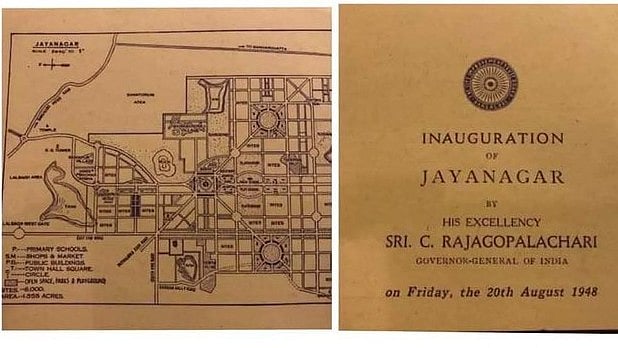
The invitation for the inauguration of Jayanagar in 1948.
Credit: X/@Tejasvi_Surya
While the debate over the viability of infrastructure projects being proposed in Bengaluru continues, a 77-year-old invitation for the inauguration of one of Bengaluru's earliest planned neighbourhoods, Jayanagar, has brought back focus on urban planning and long-term vision for city building.
Bengaluru South MP Tejasvi Surya shared the invitation, dated August 20, 1948, on X and said it is a "reminder of how Bengaluru went from Jayanagar’s planned blueprint to today’s maddening chaos".
Jayanagar, one of Asia’s earliest and thoughtfully planned urban layouts, was conceived by the Bangalore City Improvement Trust Board (CITB), the precursor to the Bangalore Development Authority (BDA). The locality, built by R Madhavan, chief engineer of the CITB, took forward the tradition of urban planning that was inculcated during the formation of the city's suburbs of Malleswaram and Basavanagudi after the catastrophic plague of the late 1890s.
Surya, in his post, said Jayanagar was built on the principles that cities like Tokyo, New York and London follow, such as grid-based planning, dedicated civic zones and markets, wide tree-lined roads and footpaths and abundant public parks and playgrounds.
"Leaders like the Mysore Maharajas and Sir M Visvesvaraya believed that cities reflected a civilisation’s discipline... Even the act of inviting the Governor-General to inaugurate a neighbourhood showed how civic growth was seen as a matter of pride, not paperwork. Urban planning was driven by engineers, architects, and visionaries – not contractors and consultants," he said.
In contrast, Surya said today’s Bengaluru reflects the collapse of that civic vision. “Where there were walkable boulevards, we have potholes and parking chaos. Where there were civic squares, we now have encroachments and flyovers,” he said.
He held successive governments, which "confused construction with development and visibility with vision", as responsible for turning institutions like the BDA into "contractors’ departments".
Surya said the city's development was now guided by short-term politics and populism rather than long-term vision.
The BJP MP said the result of this was "roads without design logic, footpaths that begin nowhere and end abruptly, drainage systems built after the rain, and metro alignments retrofitted into chaos".
Calling for returning to the ethos that created Jayanagar, Surya said to rebuild Bengaluru or any Indian city, policymakers and planners have to “plan before building, design for people, not vehicles, and treat civic dignity and urban quality of life as non-negotiable".
“The story of Jayanagar should inspire a new generation of urban reformers to ask what kind of city we want to leave behind, a monument to neglect or a model of vision and inspiration,” he said.
Incidentally, Surya, whose Lok Sabha constituency includes Jayanagar, held a meeting with Deputy Chief Minister and Bengaluru Development Minister D K Shivakumar on Tuesday to convey his objections to the 16.75-km tunnel road being planned between Hebbal and Central Silk Board, and offer suggestions on alternatives. After the meeting, he said, “Bengaluru needs sustainable transport solutions like metro, suburban rail and more buses.”
Surya has been advocating that money should be spent on sustainable projects that have long-term benefits for Bengalureans and not on car-centric infrastructure that creates new problems.
